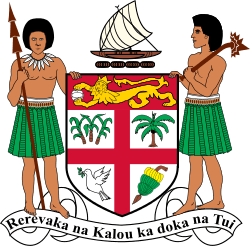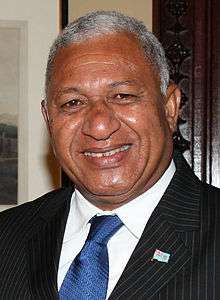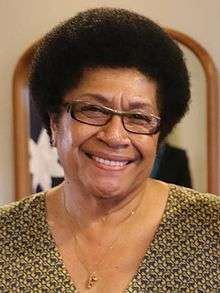Cabinet of Fiji
 |
| This article is part of a series on the politics and government of Fiji |
|
Legislative
|
|
Judiciary |
|
Fiji has the Westminster system — executive authority is vested nominally in a President, but exercised in practice by a Cabinet of ministers, presided over by the Prime Minister. The Prime Minister is formally appointed, but not chosen, by the President: the President must appoint as Prime Minister someone who can control a majority of votes in the House of Representatives. In practice, this is normally the leader of the largest political party or coalition in the house. If there is no clear majority in the House of Representatives, however, the President's role becomes more important: he or she must assume the role of arbitrator and open negotiations with the leaders of the various political parties, in the hope of finding someone whom a majority will accept as Prime Minister. In the event of that failing to take place, the President must dissolve the House of Representatives and call an early election.
The multi-party cabinet provision
Cabinet ministers are formally appointed by the President, but he is constitutionally required to do so only on the advice of the Prime Minister. An unusual feature of the 1997 Constitution is its provision for a compulsory coalition cabinet — even if one party has a parliamentary majority in its own right. Every political party with more than 8 seats in the 71‑member parliament must be offered a proportionate number of cabinet posts. If the Prime Minister wishes to give cabinet posts to members of a party with fewer than 8 representatives, he must do so at the expense of his own party, not of other parties in the coalition. This provision was written into the 1997 Constitution with a view to forcing Fiji's political parties, which represented ethnic communities for the most part, to cooperate rather than compete for absolute power. In adopting this novel feature, Fijians noted that a similar system has been operating successfully in Switzerland for decades. More recently, it has been tried (with far less success) in Northern Ireland.
Problems with the model
Until May 2006, the multi-party cabinet model was never successfully maintained in Fiji, however. The Chaudhry government refused to include the Soqosoqo ni Vakavulewa ni Taukei in the 1999-2000 cabinet, despite the party's holding the required 8 parliamentary seats. Then following the election of 2001, Mahendra Chaudhry, the leader of the Fiji Labour Party, was involved in litigation against the Prime Minister, Laisenia Qarase, on the grounds that Qarase had unconstitutionally refused to include the Labour Party in the cabinet. On 18 July 2003, Fiji's Supreme Court ruled that the exclusion of the Labour Party was in breach of the Constitution, and demanded that the situation be rectified. Amid appeals, counter-appeals, and negotiations, the situation had still not been resolved as of June 2004, when the Supreme Court handed down a further ruling that the Labour Party was entitled to 14 out of 30 posts in the cabinet. Qarase announced that he would abide by the ruling and would enlarge the cabinet to include the requisite number of Labour Party ministers, but not Chaudhry himself. This continued to stall negotiations, until late November 2004, when Chaudhry announced that the Labour Party had decided to remain in opposition for the remainder of the present parliamentary term.
Following the parliamentary election held on 6–13 May 2006, prime minister Qarase named a multi-party cabinet consisting of 24 ministers (11 SDL plus 3 SDL-affiliated senators, 9 FLP, and one independent) and 12 ministers of State (11 SDL and one independent). There was some controversy over Qarase's claim that requirement for proportional representation did not extend to the ministers of State, and that the three senators named to the cabinet, though members of the SDL, should not be counted as such for the purpose of allocating cabinet numbers. Further controversy continued since, with FLP leader Mahendra Chaudhry (who declined a cabinet post) insisting that FLP members of the cabinet owed their first loyalty to party. Prime minister Qarase, on the other hand, maintained that all ministers were bound by collective cabinet decision-making.
Calls for amendments
On 16 December 2004, prime minister Qarase announced that he would try to get Mahendra Chaudhry's agreement to amend the constitution to abolish the multi-party cabinet rule, which he called "ridiculous", and replace it with a requirement for the cabinet to be "multi-ethnic". This would require a change to Qarase's own cabinet, which at present contains only one Indo-Fijian and only two non-indigenous Fijians.
Qarase reiterated his calls for a change to the constitution on 5 October 2005, and indicated that he would contest the 2006 election on such a platform. Speaking on VitiFm Radio, Qarase said that the multi-party cabinet provisions of the constitution were unworkable and contrary to democratic principles. “Fiji should change to true democratic rule whereby whoever wins the elections governs, instead of being forced to work in a cabinet with others of different views, beliefs and ideas on how to run the government. The result will be an unworkable cabinet”, Qarase said. The provision had been hastily added to the Constitution as an afterthought, he said, and had not been given due consideration. Only three other countries had ever tried the model, none of them successfully, he claimed. “We want a stable government that can govern well and is not shaky”, he concluded.
Qarase repeated his calls for amendments on 23 December 2003. Changing the constitutional provision for a multi-party cabinet to a multi-ethnic one, he told the Fiji Village news service on 23 December, would guarantee equitable representation to all ethnic communities without requiring the government to compromise with ideologically opposite parties.
Current cabinet
After the 2014 General elections:
| Party key | FijiFirst |
|---|
| Portrait | Portfolio | Incumbent | |
|---|---|---|---|
 |
Prime Minister Minister for iTaukei Affairs Minister for Sugar Foreign Affairs |
Frank Bainimarama | |
 |
Attorney-General Minister for Justice,Finance, Public Enterprises, Public Service |
Aiyaz Sayed-Khaiyum | |
 |
Minister for Public Enterprises, Industry, Trade Tourism Lands and Mineral Resources |
Faiyaz Koya | |
.jpg) |
Minister for Immigration National Security and Defence |
Inoke Kubuabola | |
 |
Minister for Fisheries | Semi Koroilavesau | |
 |
Minister for Women, Children and Poverty Alleviation | Mereseini Vuniwaqa | |
 |
Minister for Local Government, Urban Development and Housing Environment and Infrastructure Public Works and Transport |
Parveen Bala | |
 |
Minister for Health and Medical Services | Rosy Akbar | |
 |
Minister for Education, National Heritage, Culture and Arts | Mahendra Reddy | |
 |
Minister for Youth and Sports | Laisenia Tuitubou | |
 |
Minister for Agriculture, Natural Disaster Management | Inia Seruiratu | |
 |
Minister for Employment Opportunities, Productivity and Industrial Relations | Jone Usamate | |
 |
Minister for Forestry | Osea Naiqamu | |
| | |||
 |
Assistant Minister for Local Government, Housing and Environment | Lorna Eden | |
| 75px | Assistant Minister for Agriculture, Natural Disaster Management | Joeli Cawaki | |
 |
Assistant Minister for Women, Children and Poverty Alleviation | Veena Bhatnagar | |
 |
Assistant Minister for Health | Alex O'Connor | |
 |
Assistant Minister for Infrastructure and Transport | Vijay Nath | |
 |
Assistant Minister for Youth and Sports | Iliesa Delana | |
 |
Assistant Minister for Education, Heritage and Arts | Vacant | |
| | |||
 |
Speaker of the House | Jiko Luveni | |
 |
Leader of Opposition | Teimumu Kepa | |
 |
Foremr FijiFirst cabinet minister, now President of Fiji | Jioje Konrote | |
The interim cabinet
A military coup deposed the Qarase government on 5 December 2006. The coup leader, Commodore Frank Bainimarama reached an agreement with deposed President Ratu Josefa Iloilo whereby Iloilo would be reinstated as president and Bainimarama sworn in as interim Prime Minister. Bainimarama was duly sworn in on 5 January 2007. Eight cabinet ministers were appointed on 8 January and another six on 9 January; a fifteenth, Ratu Epeli Ganilau, was sworn in as Minister for Fijian Affairs on 15 January.
Initial cabinet
| Portfolio | Minister | Profile |
| Prime Minister, Minister for Information, Minister for Home Affairs | Commodore Josaia Voreqe (Frank) Bainimarama | Commander, Republic of Fiji Military Forces. |
| Minister for Finance, Minister for Sugar Reform, Minister for National Planning | Mahendra Chaudhry | Fiji Labour Party (FLP) leader; Prime Minister 1999-2000 (deposed). |
| Minister for Youth and Sports | Lekh Ram Vayeshnoi | FLP politician since 1992; former Cabinet Minister. |
| Minister for Local Government, Minister for Urban Development | Ratu Jone Navakamocea | State Minister for National Planning in the deposed SDL-led government. |
| Minister for Labour, Minister for Tourism | Bernadette Rounds Ganilau | Served as one of two United Peoples Party parliamentarians in 2006. Former Tourism Minister (2000-2001). |
| Minister for Lands and Mineral Resources | Tevita Vuibau | Marine geologist with a background as Principal Scientific Officer with the Mineral Resources Department. |
| Minister for Agriculture, Fisheries, and Forests | Jainend Kumar | Retired Director of Research with the Agriculture, Sugar, and Land Resettlement Ministry. |
| Attorney-General, Minister for Justice | Aiyaz Sayed-Khaiyum | Former President of Fiji Young Lawyers Association. |
| Minister for Foreign Affairs Minister for External Trade | Ratu Epeli Nailatikau | Former Military Commander, diplomat, Cabinet Minister, and Parliamentary Speaker (2001-2006). Son of high chief and prominent politician, Ratu Sir Edward Cakobau; son-in-law of first Prime Minister and former President, Ratu Sir Kamisese Mara. |
| Minister for Public Service, Minister for Public Service Reform | Poseci Bune | Veteran civil servant and diplomat; FLP Environment Minister in the deposed government. Estranged from party leader Mahendra Chaudhry. |
| Minister for Health | Jona Senilagakali | Military doctor and former diplomat; interim Prime Minister for one month after coup of 5 December 2006. |
| Minister for Education | Lieutenant Commander Netani Sukanaivalu | Reserve naval officer, former Fiji Institute of Technology lecturer, and businessman. National Alliance Party (NAPF) candidate in 2006 election. |
| Minister for Transport | Manu Korovulavula | Longtime civil servant and former Senator; NAPF treasurer and candidate in 2006 election. |
| Minister for Commerce | Taito Waradi | Businessman and President, Fiji Chamber of Commerce. |
| Minister for Women, Minister for Social Welfare | Adi Laufitu Malani | Scion of the chiefly Gonesau clan of Nakorotubu, Ra Province; former regional director of the United Nations Development Fund for Women. |
| Minister for Fijian Affairs | Ratu Epeli Ganilau | Scion of the chiefly Ai Sokula clan; son of first President Ratu Sir Penaia Ganilau and son-in-law of first Prime Minister and second President, Ratu Sir Kamisese Mara. |
References
Sources
- Profile of Fiji's interim cabinet members (Fiji Times, 9 January 2006).
- Fijian parliamentary website